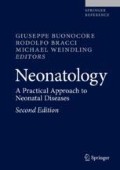Abstract
Despite the emphasis on major disabling conditions, most survivors of very preterm or extremely preterm birth have mild or no impairments as they enter childhood. Alongside the major conditions discussed in Chap. 133, “Epidemiology of Adverse Cerebral Outcome of Newborns,” a range of important cognitive, behavioral, and motor problems are now well recognized and persist into adult life. Alongside these are rarely considered important issues relating to lung function and cardiovascular health that also require consideration. This chapter will briefly review these areas and signpost further reading.
Access this chapter
Tax calculation will be finalised at checkout
Purchases are for personal use only
References
Aarnoudse-Moens CS, Weisglas-Kuperus N, van Goudoever JB et al (2009) Meta-analysis of neurobehavioral outcomes in very preterm and/or very low birth weight children. Pediatrics 124(2):717–728
Bolton CE, Stocks J, Hennessy E et al (2012) The EPICure study: association between hemodynamics and lung function at 11 years after extremely preterm birth. J Pediatr 161(4):595–601 e2
Cooke RW (2004) Health, lifestyle, and quality of life for young adults born very preterm. Arch Dis Child 89(3):201–206
Edwards J, Berube M, Erlandson K et al (2011) Developmental coordination disorder in school-aged children born very preterm and/or at very low birth weight: a systematic review. J Dev Behav Pediatr 32(9):678–687
Farooqi A, Hagglof B, Serenius F (2013) Behaviours related to executive functions and learning skills at 11 years of age after extremely preterm birth: a Swedish national prospective follow-up study. Acta Paediatr 102(6):625–634
Fawke J, Lum S, Kirkby J et al (2010) Lung function and respiratory symptoms at 11 years in children born extremely preterm: the EPICure study. Am J Respir Crit Care Med 182(2):237–245
Hack M, Flannery DJ, Schluchter M et al (2002) Outcomes in young adulthood for very-low-birth-weight infants. N Engl J Med 346(3):149–157
Hack M, Schluchter M, Cartar L et al (2003) Growth of very low birth weight infants to age 20 years. Pediatrics 112(1 Pt 1):e30–e38
Hille ET, den Ouden AL, Saigal S et al (2001) Behavioural problems in children who weigh 1000 g or less at birth in four countries. Lancet 357(9269):1641–1643
Johnson S, Marlow N (2011) Preterm birth and childhood psychiatric disorders. Pediatr Res 69(5 Pt 2):11R–18R
Johnson S, Wolke D (2013) Behavioural outcomes and psychopathology during adolescence. Early Hum Dev 89(4):199–207
Kerr-Wilson CO, Mackay DF, Smith GC et al (2012) Meta-analysis of the association between preterm delivery and intelligence. J Public Health 34(2):209–216
Linsell L, Malouf R, Morris J et al (2015) Prognostic factors for poor cognitive development in children born very preterm or with very low birth weight: A systematic review. JAMA Pediatr 169(12):1162–1172
Lum S, Kirkby J, Welsh L et al (2011) Nature and severity of lung function abnormalities in extremely pre-term children at 11 years of age. Eur Respir J 37(5):1199–1207
MacKay DF, Smith GC, Dobbie R et al (2010) Gestational age at delivery and special educational need: retrospective cohort study of 407,503 schoolchildren. PLoS Med 7(6), e1000289
Mathiasen R, Hansen BM, Andersen AM et al (2010) Gestational age and basic school achievements: a national follow-up study in Denmark. Pediatrics 126(6):e1553–e1561
Moore T, Hennessy EM, Myles J et al (2012) Neurological and developmental outcome in extremely preterm children born in England in 1995 and 2006: the EPICure studies. BMJ 345, e7961
Mulder H, Pitchford N, Hagger M et al (2009) Development of executive function and attention in preterm children: a systematic review. Develop Neuropsychol 34(4):393–421
Mulder H, Pitchford N, Marlow N (2010) Processing speed and working memory underlie academic attainment in very preterm children. Arch Dis Child Fetal Neonatal Ed 95:F267–F272
Mulder H, Pitchford NJ, Marlow N (2011a) Processing speed mediates executive function difficulties in very preterm children in middle childhood. J Int Neuropsychol Soc 17:1–10
Mulder H, Pitchford NJ, Marlow N (2011b) Inattentive behaviour is associated with poor working memory and slow processing speed in very pre-term children in middle childhood. Br J Educ Psychol 81(Pt 1):147–160
Saigal S, Stoskopf B, Streiner D et al (2006) Transition of extremely low-birth-weight infants from adolescence to young adulthood: comparison with normal birth-weight controls. JAMA 295(6):667–675
Saigal S, Day KL, Van Lieshout RJ et al (2016) Health, wealth, social integration, and sexuality of extremely low-birth-weight prematurely born adults in the fourth decade of life. JAMA Pediatr 170(7):678–686
Scherif G (2010) Attention trajectories, mechanisms and outcomes: at the interface between developing cognition and environment. Dev Sci 13:805–812
Simms V, Gilmore C, Cragg L et al (2015) Nature and origins of mathematics difficulties in very preterm children: a different etiology than developmental dyscalculia. Pediatr Res 77(2):389–395
Spittle A (2015) Early intervention cognitive effects not sustained past preschool. J Pediatr 166(3):779
Spittle A, Orton J, Anderson PJ et al (2015) Early developmental intervention programmes provided post hospital discharge to prevent motor and cognitive impairment in preterm infants. Cochrane Database Syst Rev 11, CD005495
Van Hus JW, Potharst ES, Jeukens-Visser M et al (2014) Motor impairment in very preterm-born children: links with other developmental deficits at 5 years of age. Dev Med Child Neurol 56(6):587–594
Volpe JJ (2009) Brain injury in premature infants: a complex amalgam of destructive and developmental disturbances. Lancet Neurol 8(1):110–124
Wolke D, Baumann N, Strauss V et al (2015) Bullying of preterm children and emotional problems at school age: cross-culturally invariant effects. J Pediatr 166(6):1417–1422
Author information
Authors and Affiliations
Corresponding author
Editor information
Editors and Affiliations
Rights and permissions
Copyright information
© 2018 Springer International Publishing AG, part of Springer Nature
About this entry
Cite this entry
Marlow, N. (2018). Follow-Up Outcomes of High-Risk Infants. In: Buonocore, G., Bracci, R., Weindling, M. (eds) Neonatology. Springer, Cham. https://doi.org/10.1007/978-3-319-29489-6_163
Download citation
DOI: https://doi.org/10.1007/978-3-319-29489-6_163
Published:
Publisher Name: Springer, Cham
Print ISBN: 978-3-319-29487-2
Online ISBN: 978-3-319-29489-6
eBook Packages: MedicineReference Module Medicine

